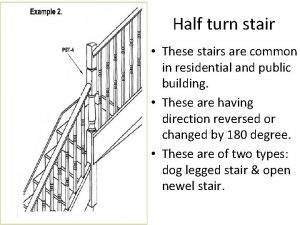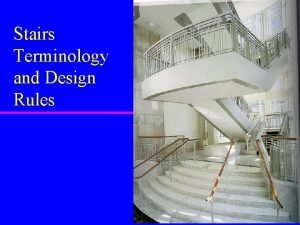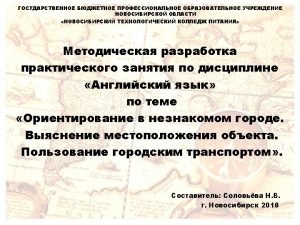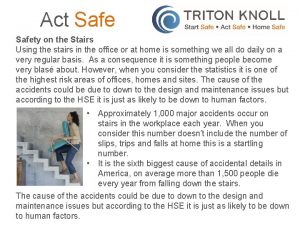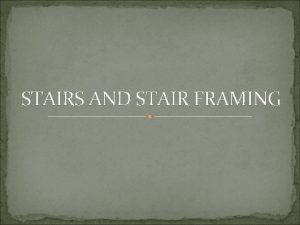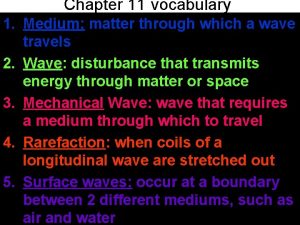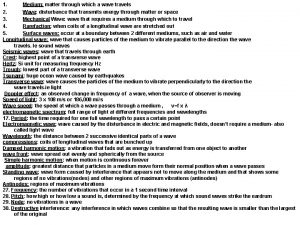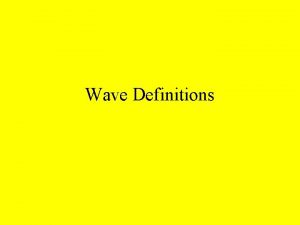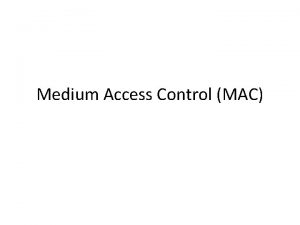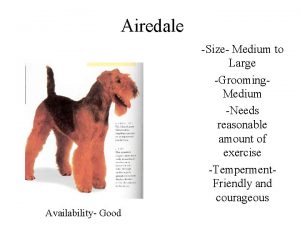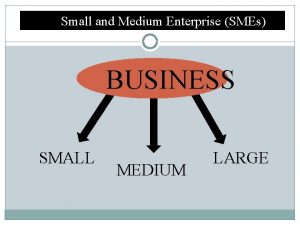STAIRS Stairs are the medium through which a





































- Slides: 37

STAIRS


“Stairs are the medium through which a person can travel from one horizontal level to another horizontal level”. Or “A stair is a set of steps leading from one floor to the other. It is provided to afford the means of ascent and descent between various floors of the building”. Divide larger vertical distance in to smaller vertical distances called steps. STAIRCASE: The room or enclosure of the building, in which the stair is located, is known as staircase.

ØThe opening or space occupied by the stair is known as a stairway. ØIn a domestic building the stairs should be centrally located to provide easy access to all rooms. ØIn public buildings, stairs should be located near the entrance. ØStairs may be constructed by timber, bricks, stone, steel or reinforced cement concrete.

ØStaircases provide access and communication between floors in multi-storey buildings. ØThey are a path by which fire can spread from one floor to another. ØStaircase, therefore, must be enclosed by fire resisting walls, floors, ceiling and doors. ØAnother important aspect in the design of stairs is the strength aspect. It must be designed to carry certain loads, which are similar to those used for the design of floor.



The technical terms associated with the design and constructions of stairs are: TREAD: it is the upper horizontal portion of a step upon which the foot is placed while ascending or descending. RISER: it is the vertical portion of a step providing a support to the tread. FLIGHT: this is defined as an unbroken series of steps between landings. LANDING: it is the level platform at the top or bottom of a flight between the floors. A landing facilitates change of direction and provides an opportunity for taking rest during the use of the stair.

RISE: it is the vertical distance between two successive tread faces. GOING or RUN: it is the horizontal distance between two successive riser faces. STRINGS AND STRINGERS: these are the slopping members which support the steps in a stair. They run along the slope of the stair. NEWEL POST: newel post is a vertical member which is placed at the ends of flights to connect the ends of strings and hand rail.

BALUSTER: it is vertical member of wood or metal, supporting the hand rail. HAND RAIL: it is the surrounded or moulded member of wood or metal following generally the contour of the nosing line, and fixed on the top of balusters. NOSING : It is the projecting part of the tread beyond the face of the riser. It is rounded to give good architectural effect. WINDERS : Angular steps which give a change of direction from one flight of steps to another.


Types of Landings Half Space Landing: • Change stair direction 180⁰ • Landing width = width of stair (min 750 mm) • Used in Dogleg Stairs

Quarter Space Landing: • Change Stair Direction 90⁰ • Landing Width & Length = Stair Width • Forms Quarter Turn Stair (min 750 mm)

Intermediate Landing: • Allows the Stair to continue in same direction • Required where more than 18 Risers • May be used to give a rest • Width = Stair Width • Length = Stair Width or greater

Types of staircases Based on type of Material: 1. Wooden Stair 2. Stone Stair 3. Steel Stair 4. Reinforced Cement Concrete Stair 5. Brick stair

TIMBER STAIRS: ØThese stairs are light in weight and easy to construct. ØThey are very poor in resisting fire. Ø They are used only for small rise residential buildings. ØSometimes, fire resisting hard wood of proper thickness may be used.

STONE STAIRS: ØThese are widely used at places where ashlar stone is readily available. ØStone used for construction of stairs should be hard, strong and resistant to wear. ØThe simplest form of stone stairs is those supported on both the ends.

METAL STAIRS: ØStairs of mild steel or cast iron are used only as emergency stairs. Ø They are not common in residential and public buildings, though they are strong and fire resistant. ØThese are commonly used in factories, godowns, workshops, etc.

R. C. C: ØThese are the stairs widely used for residential, public and industrial buildings. ØThey are strong, hard wearing and fire resisting. ØThese are usually cast- in – situ and a wide variety of finishes can be used on these.

BRICK STAIRS: ØThese are not very common, except at the entrance. ØHowever, brick stairs of single straight flight are often made in village houses. Ø The stairs consist of either solid wall, or also, arched openings may be left for obtaining storage space.

GLASS STAIRS: ØThis type of stairs is not commonly used. ØIt is usually used in places were appearance is of utter importance. ØIt can be easily damaged. ØGlass is brittle in nature, hence harmful. ØTread edges are sharp, which may hurt while ascending and descending. ØThey are not strong.

Types of Stairs : 1. 2. 3. 4. 5. 6. 7. 8. Straight Stair Dog legged Stair Quarter turn Stair Open newel Stair Three quarter turn Stair Bifurcated Stair Geometrical Stair Circular Stair

Straight stairs: ØAll steps lead in one direction ØThis may be continuous with two flights with an intermediate landing ØAdopted when staircase is narrow and long ØProvided mostly in veranda, entrance etc.

Dog-legged Stairs: ØConsists of two straight flights running in opposite directions ØThere is no space between the flights in plan ØLanding is provided at level where direction of flight changes. ØThis type of stair is useful where the width of the staircase hall is just sufficient to accommodate two width of stair.


Quarter Turn Stairs: ØA stair turning through one right angle is known as quarter turn stair. ØQuarter turn stairs run straight in a flight and after reaching the landing changes its direction. ØThis stairs turns either to left or right at 90° degree. ØIt runs again till it reaches the consecutive horizontal level.

Open Newel Stairs: ØPopularly known as open well stairs. ØIn these type of stair there is a well or opening between the flights in plan. ØThis well may be rectangular or of any geometrical shape ØA well or opening is left between forward and backward flight ØThe opening is generally used for installation of lift ØA short flight may or may not be provided in these stairs.

Three Quarter Turn Stair: ØA stair turning through right angles is known as three quarter turn stair. ØThis has its direction changes to 270°. ØIn this case an open well is formed. ØSome flights have very few risers (only 3 -4).


Bifurcated Stairs: ØThese stair are so arranged that there is a wide flight at the start which is further sub-divided into two narrow flights at the mid-landing. ØThe two narrow flight starts from either side of the mid-landing. ØThese stairs are suitable for modern sub building.

Geometrical Stairs: ØThese stairs may have any geometrical shape and they require no newel post. ØThis type of stair is similar to open newel stair except the well formed between forward and backward flight is curved. ØChange of direction in such stairs is achieved by winders and not by landings.

Circular or Spiral Stairs: ØIt is known as spiral stair. ØWhen viewed from top it appears to follow a circle with a single centre of curvature. ØThe spiral stairs are provided where space available is limited and traffic is low. ØThese stairs can be constructed in R. C. C. , Steel or Stone

Essential Requirements of good Staircase: ØLocation of the staircase should be such as to provide easy access to the occupants. ØIt should be well ventilated, especially at turns. ØWidth of the stair should be adequate for the users. 1. Minimum 1000 mm for Residential Buildings. 2. Minimum 1350 mm for Public Buildings. ØThe slope of the stair should not exceed 40° and it should never be less than 25°.

ØThe number of steps in a flight should be restricted to a maximum of 12, from comfort point of view and a minimum of 3. ØHeadroom of desirable height, 2300 mm should be provided. ØWidth of the landing should not be less than width of the stair. ØMaterials used in the construction of stairs should be sound and fire proof. ØAll the risers and treads should be of uniform dimensions.

ØWinders should be avoided as far as possible. Type of Building Maximum Riser Minimum Tread Public Building 150 mm 300 mm Domestic Building 190 mm 250 mm . ØHand rail: When a flight consists of more than 3 steps, a hand rail at least on one side is considered to be necessity. The wide stairs should be provided with hand rails on both the sides. Very wide stairs, as required for public buildings, should be provided with residential hand rail. The height of hand rail above the should be approximately 800 mm.

Geometrical design of stairs • The height of floor is generally known. The procedure for determining the number of treads and risers is as follows • A convenient height of the riser is assumed • Number of risers = total height of floor / Height of riser • Number of treads in a flight =number of risers-1 • This is due to the fact that the surface of the upper floor forms the tread for the top step ØRise + Tread not < 400 mm & not > 450 mm. Ø 2 x Rise + Tread = 600 mm. Not < 580 & not > 630 mm. ØRise x Tread = 4000 to 4100 mm and not > 5000 mm

• Problems: The inside dimensions of a staircase in a residential building are 2. 00 m x 4. 60 m. The height of floor is 3. 30 m and the roof consists of RCC slab of 120 mm thickness. Design a proper layout of an RCC stair for this building. • Solution: Adopt a dog-legged stair Assuming a convenient height of riser=180 mm Then, Number of risers= Total height of floor/Height of riser = (3. 30 +0. 12) /180 =19 In order to provide suitable headroom below landing level, provide 12 risers in the first flight and 7 risers in the second flight. Assume a tread of 230 mm No. of treads in the first flight = No. of risers -1 = (12 -1)=11 Width left for landings = (4600 -11 x 230) =2070 mm
 Antigentest åre
Antigentest åre Types of half turn staircase
Types of half turn staircase Cold media examples
Cold media examples Vydj
Vydj Sound waves from a radio generally travel in which medium?
Sound waves from a radio generally travel in which medium? Factors affecting the communication process
Factors affecting the communication process Ehat is sound
Ehat is sound By one man sin
By one man sin Classes of furcation
Classes of furcation Advantage of through and through sawing
Advantage of through and through sawing Night of scorpion poem
Night of scorpion poem Hình ảnh bộ gõ cơ thể búng tay
Hình ảnh bộ gõ cơ thể búng tay Lp html
Lp html Bổ thể
Bổ thể Tỉ lệ cơ thể trẻ em
Tỉ lệ cơ thể trẻ em Chó sói
Chó sói Chụp phim tư thế worms-breton
Chụp phim tư thế worms-breton Chúa sống lại
Chúa sống lại Môn thể thao bắt đầu bằng chữ đua
Môn thể thao bắt đầu bằng chữ đua Thế nào là hệ số cao nhất
Thế nào là hệ số cao nhất Các châu lục và đại dương trên thế giới
Các châu lục và đại dương trên thế giới Công thức tiính động năng
Công thức tiính động năng Trời xanh đây là của chúng ta thể thơ
Trời xanh đây là của chúng ta thể thơ Mật thư tọa độ 5x5
Mật thư tọa độ 5x5 Phép trừ bù
Phép trừ bù độ dài liên kết
độ dài liên kết Các châu lục và đại dương trên thế giới
Các châu lục và đại dương trên thế giới Thơ thất ngôn tứ tuyệt đường luật
Thơ thất ngôn tứ tuyệt đường luật Quá trình desamine hóa có thể tạo ra
Quá trình desamine hóa có thể tạo ra Một số thể thơ truyền thống
Một số thể thơ truyền thống Cái miệng bé xinh thế chỉ nói điều hay thôi
Cái miệng bé xinh thế chỉ nói điều hay thôi Vẽ hình chiếu vuông góc của vật thể sau
Vẽ hình chiếu vuông góc của vật thể sau Nguyên nhân của sự mỏi cơ sinh 8
Nguyên nhân của sự mỏi cơ sinh 8 đặc điểm cơ thể của người tối cổ
đặc điểm cơ thể của người tối cổ Thế nào là giọng cùng tên
Thế nào là giọng cùng tên Vẽ hình chiếu đứng bằng cạnh của vật thể
Vẽ hình chiếu đứng bằng cạnh của vật thể Tia chieu sa te
Tia chieu sa te Thẻ vin
Thẻ vin

